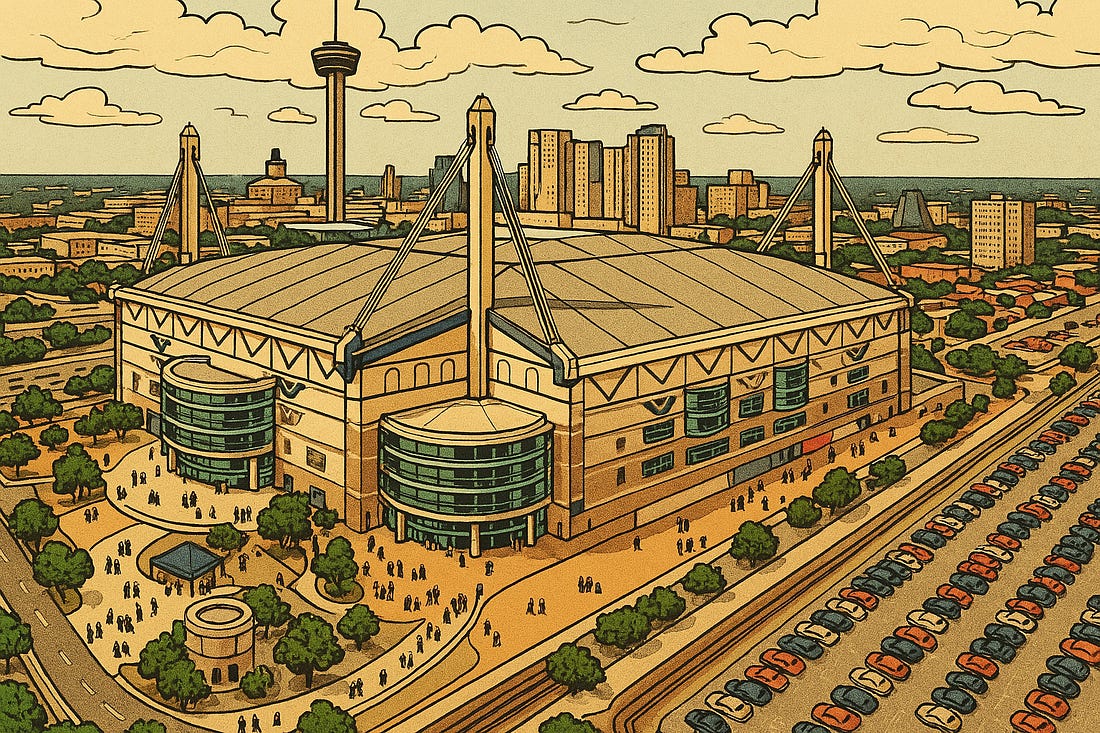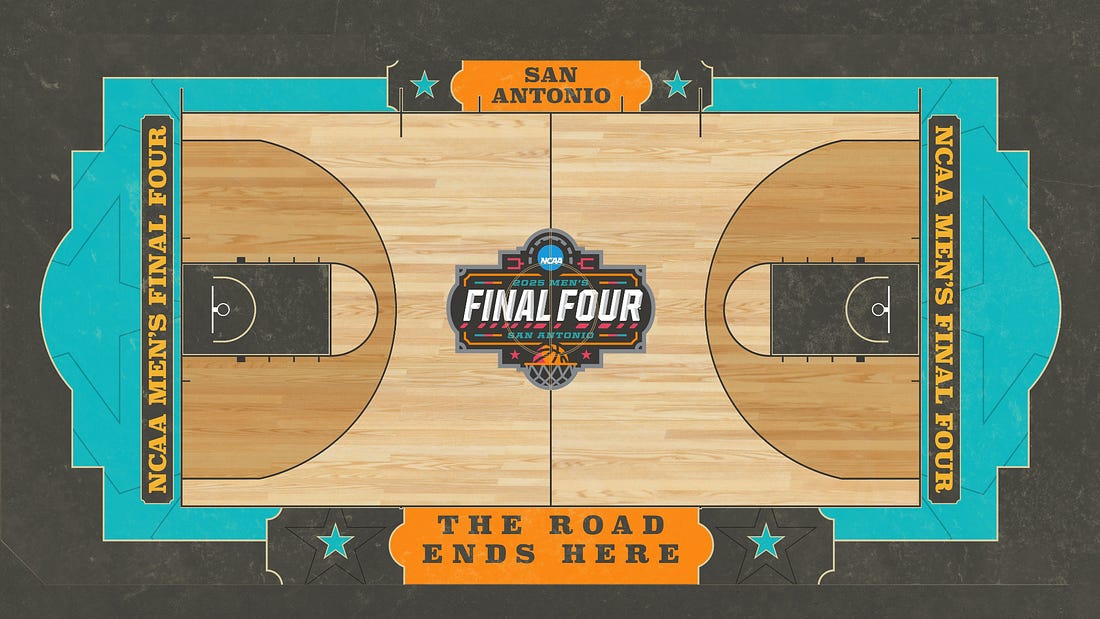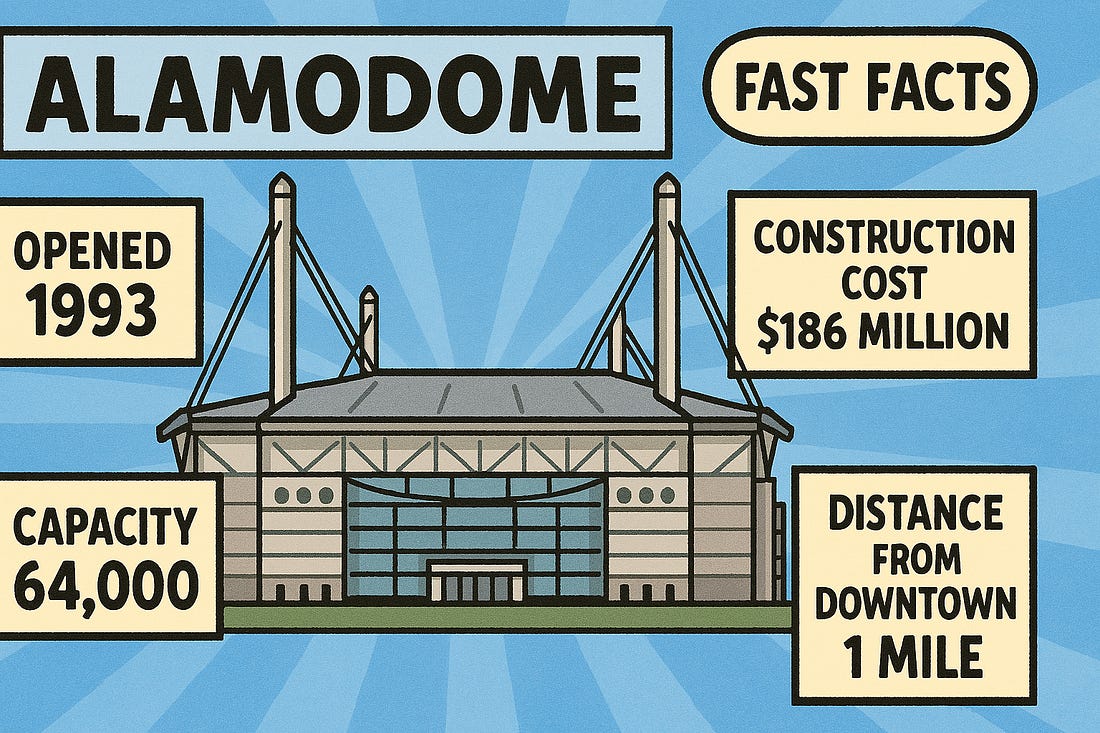From NFL Rejection to Final Four Fame: The Alamodome’s Comeback Story
From NFL Rejection to Final Four Fame: The Alamodome’s Comeback StoryThe Alamodome is a no-frills stadium with no NFL team, yet it’s hosting college basketball’s biggest weekend (for the fifth time). Today’s newsletter explains why.
With the NCAA choosing to host the Final Four in large indoor football stadiums every year since 1997, the Alamodome has spent the last few years preparing for this year’s tournament. Initially built to lure an NFL expansion team to San Antonio, the 64,000-seat venue is set to host its fifth NCAA Final Four in thirty years this weekend. The preparation process started last year when the City of San Antonio approved $30 million in upgrades to build 18 new luxury suites, and it will continue all the way up to tipoff as the stadium crew rushes to install temporary seats and even new hardwood. The court itself was custom-built by a company named Connor Sports. Crafted from maple hardwood sourced from Michigan, the 70-foot by 140-foot court was painted with custom graphics before being shipped to San Antonio in 381 individual panels. These panels each measure 4-by-7 feet and weigh 165 pounds. A team of technicians and Alamodome staff members then spend about four hours assembling the pieces on-site. Similar to previous Final Fours, the basketball court will be raised several feet above ground level to improve sightlines for spectators and broadcast TV cameras. The NCAA will say that they have moved the Final Four into football stadiums so that more fans could attend the experience, but it’s really about money. A 50,000-seat difference at $200 per ticket translates to $10 million more in ticket sales per game. Over the years, I’ve become fascinated with stadium architecture. I think the reason it interests me so much is that every stadium is different. Depending on the sport or location, the venue might be indoor or outdoor, big or small, simple or luxurious. The finances are always complex — is it privately or publicly funded? Who actually owns the venue? — and the real estate surrounding stadiums has become its own business. The Alamodome is the perfect example of this uniqueness. While many people would probably call it a failure because the City of San Antonio initially built it to secure an NFL expansion team, it’s quite the opposite. The Alamodome has proven that you can build a large venue that is always full and financially viable without a marquee tenant. One of my favorite facts about the Alamodome is that it was built debt-free. The City of San Antonio implemented a half-cent transportation tax before construction began to fund the project, enabling them to recoup the $186 million investment in 18 months. Even after accounting for inflation, the Alamodome’s construction cost is still just $410 million — a far cry from the multi-billion dollar NFL stadiums we see today. Huddle Up is a reader-supported publication. To receive new posts and support my work, consider becoming a free or paid subscriber. This no-frills approach is one reason San Antonio wasn’t awarded an NFL expansion team in the first place. Jerry Jones and the Dallas Cowboys fought hard to prevent a team from landing in Texas, and as luxury suites became an increasingly large part of a team’s business, the NFL awarded expansion teams to Carolina and Jacksonville. But rather than allowing the Alamodome to become a wasteland like so many other large-scale venues without marquee tenants, San Antonio pivoted. The Alamodome now hosts various events each year, including high school football and basketball games, band competitions, A-list concerts, and college football’s Valero Alamo Bowl. The Alamodome was also home to the NBA’s San Antonio Spurs before the team moved to the Frost Bank Center (formerly the AT&T Center) in 2002. The University of Texas at San Antonio (UTSA) has played its home football games at the Alamodome since its inaugural season in 2011, and the New Orleans Saints used the stadium for their home games in 2005 after Hurricane Katrina damaged the Superdome. The Alamodome is one of the only venues in the world to host NFL, NBA, MLB, and NHL games, but it doesn’t stop there. The venue is full at least 150 nights a year because they also host other events like WWE’s Royal Rumble and boxing matches. Billy Graham’s religious crusade at the Alamodome in 1997 drew a record crowd of over 74,000 attendees, and the San Antonio Spurs returned to their former stadium last year to set a new NBA record when 70,000 fans watched them play the Warriors. This variety of events has made the Alamodome a financial success. Although the venue typically loses a few million dollars annually, the City of San Antonio is okay with that because it generates billions in economic impact for local businesses. The venue actually turned a small profit last year at $329,000 on estimated revenue of $20.2 million, breaking a long streak of annual losses in nine of the previous ten years that totaled $26.2 million. However, with San Antonio expecting 100,000 out-of-town visitors this weekend who will collectively spend over $50 million on hotel bookings alone, the true financial impact of the stadium goes well beyond traditional metrics. The Alamodome is an outlier in today’s sports world. While every other venue seeks to maximize revenue through luxury suites and club-level spaces fitted with expensive restaurants, the Alamodome is like a Honda Civic — nothing fancy, just reliable. The venue was built in a relatively tight space between a railroad track and a highway, so it’s much more vertical than some of its predecessors. Stadium architects also built a unique cable-supported truss system with material shipped in from Europe. This system eliminated all view-obstructing columns inside the stadium, creating ideal sightlines that make even the furthest seats feel that much closer to the action. Like many cities and sports franchises, San Antonio is currently in the process of planning a new downtown sports and entertainment district. This district, which includes a new arena for the Spurs and upgrades to the Alamodome, is estimated to cost at least $3.3 billion and would require an increased hotel and rental car tax. The Spurs have already indicated that they don’t plan to play past their 2032 lease end date at Frost Bank Arena, but who knows what will happen. These projects require legislative approval, and the planning process alone often lasts more than five years. But don’t expect the Final Four to ditch the Alamodome anytime soon. Similar to the NFL’s process to determine Super Bowl hosts, the NCAA has a laundry list of requirements for the Final Four. In fact, the NCAA’s list is so complex, encompassing venue size, airports, hotel rooms, and more, that only 11 cities in the country are capable of hosting the men’s Final Four based on the minimum bid specifications. San Antonio will probably have to spend more money on renovations if it wants to keep the tournament coming back every few years, but that shouldn’t be a problem. The Alamodome is a gem in a world full of diamonds. It may not have the same buzz-worthy amenities as some of the country’s newer venues, but it’s incredibly efficient. The stadium was built with cheap capital within walking distance of downtown. It provides local residents with hundreds of events each year. The average fan hasn’t been priced out due to unnecessary upgrades, and local businesses benefit more than anyone else, with millions of visitors each year and billions in economic impact. If you enjoyed this breakdown, share it with your friends. Huddle Up is a 3x weekly newsletter that breaks down the business and money behind sports. If you are not a subscriber, sign up and join 130,000+ others who receive it directly in their inbox each week. You’re currently a free subscriber to Huddle Up. For the full experience, upgrade your subscription.
© 2025 |



